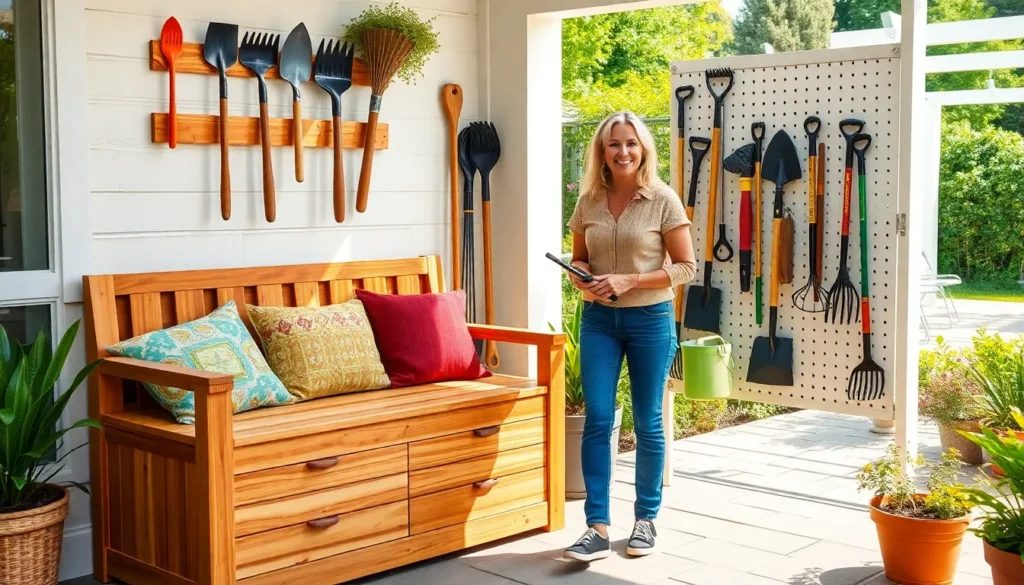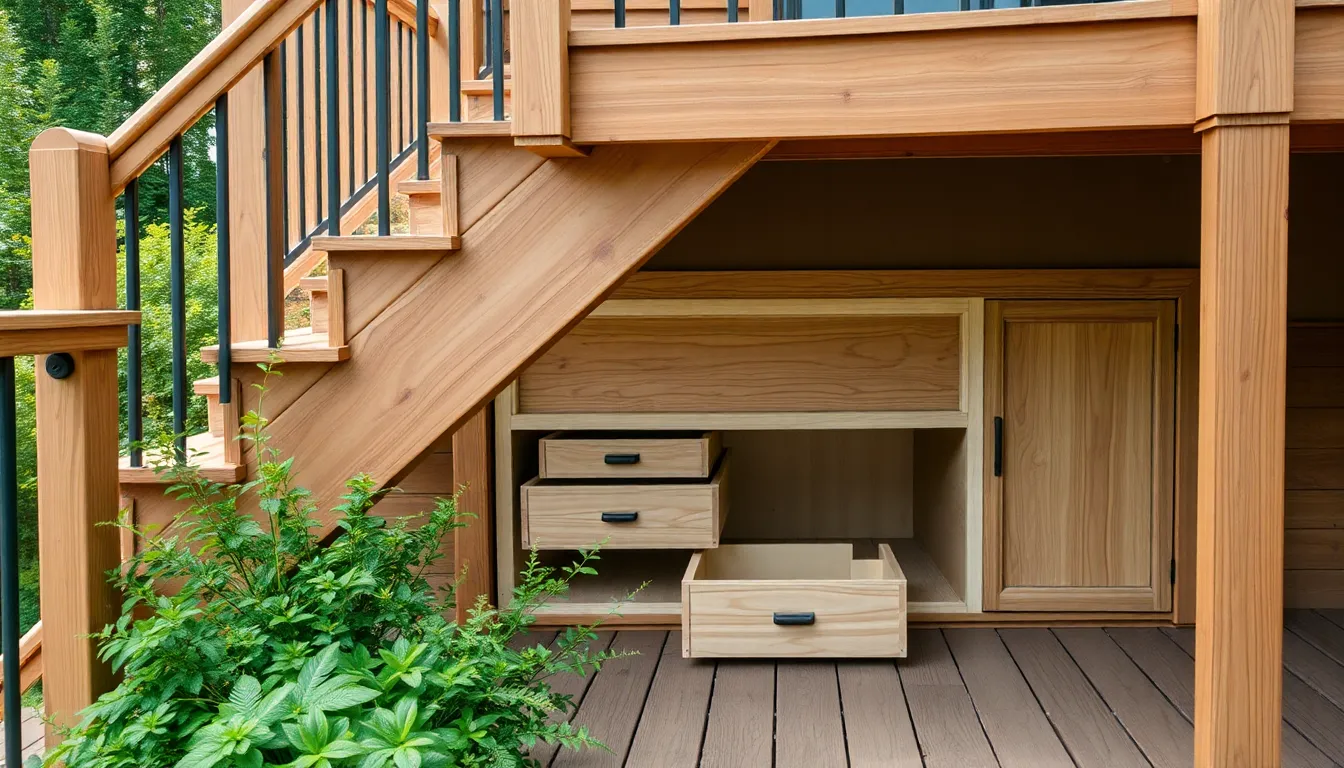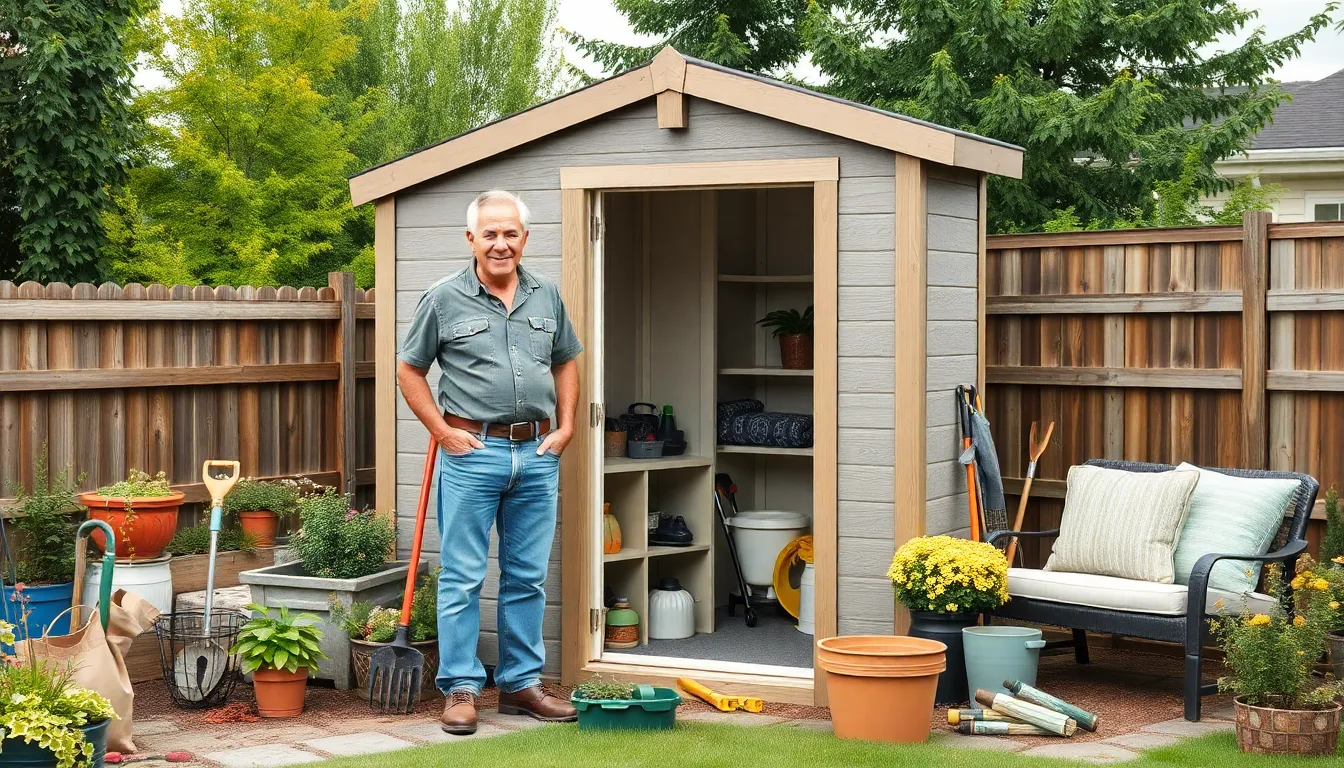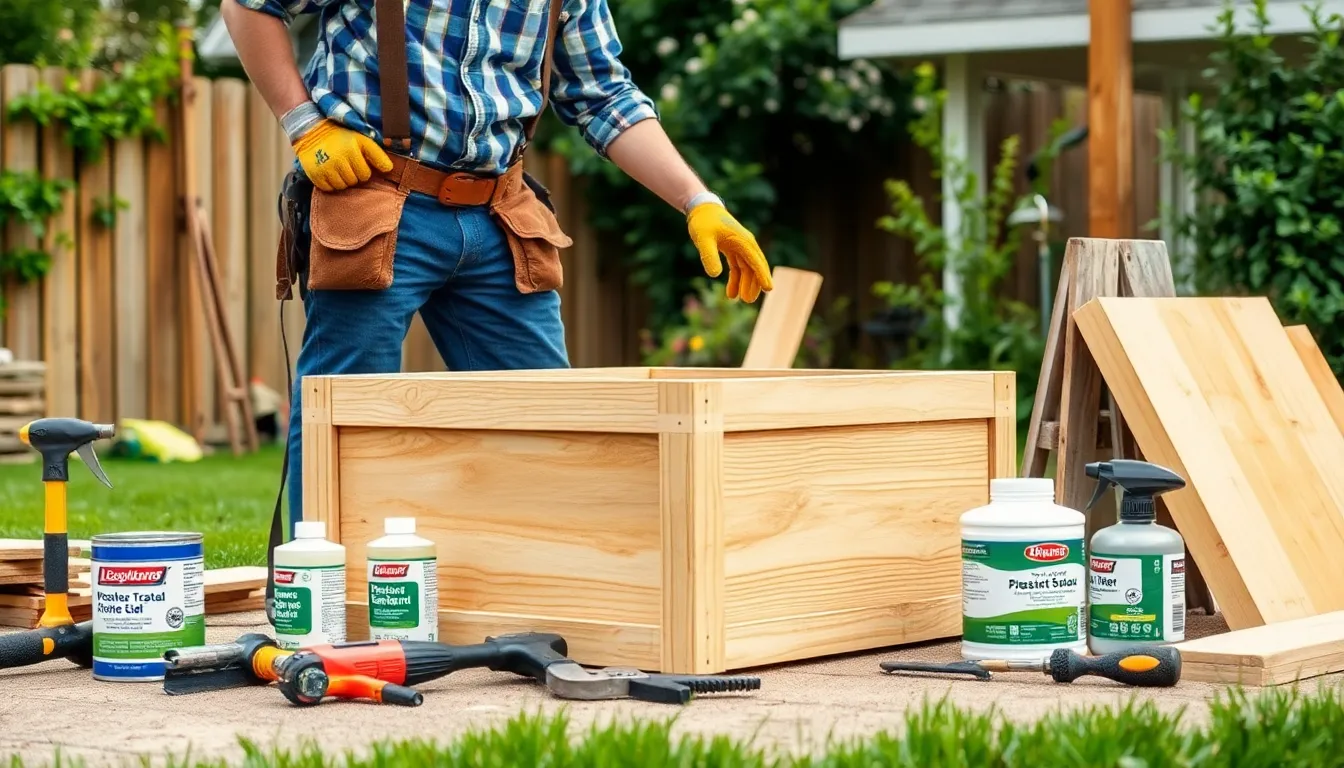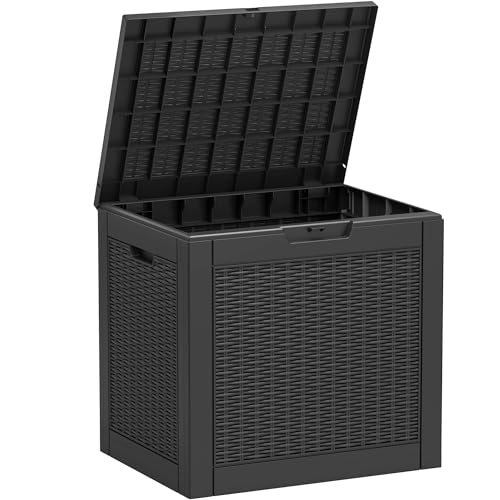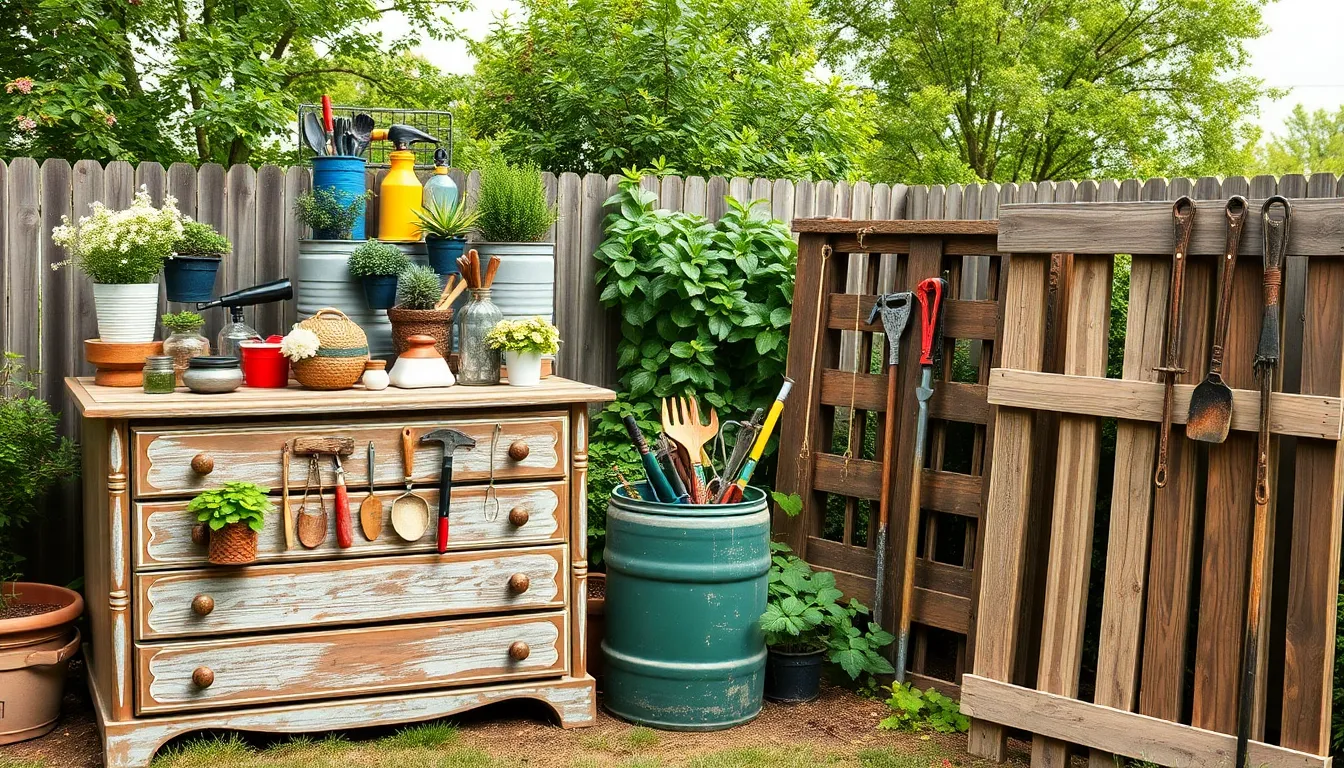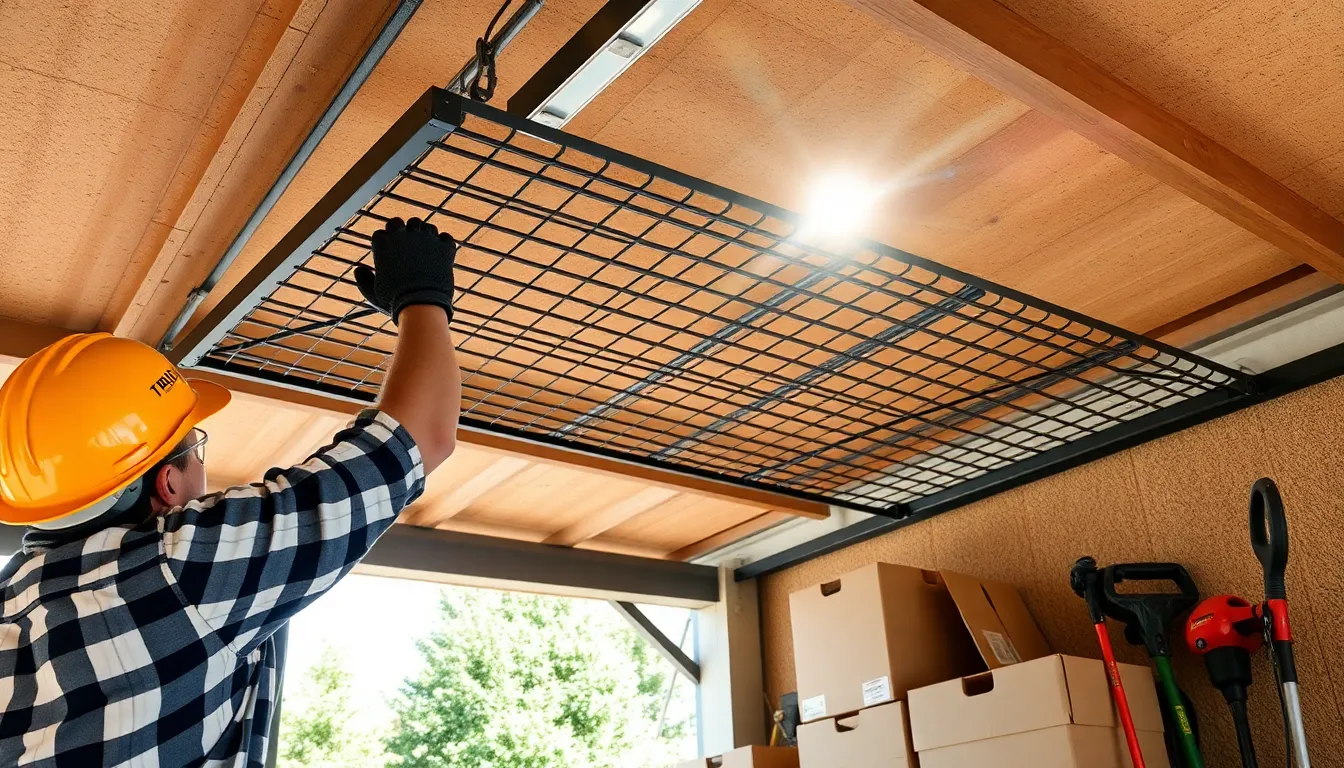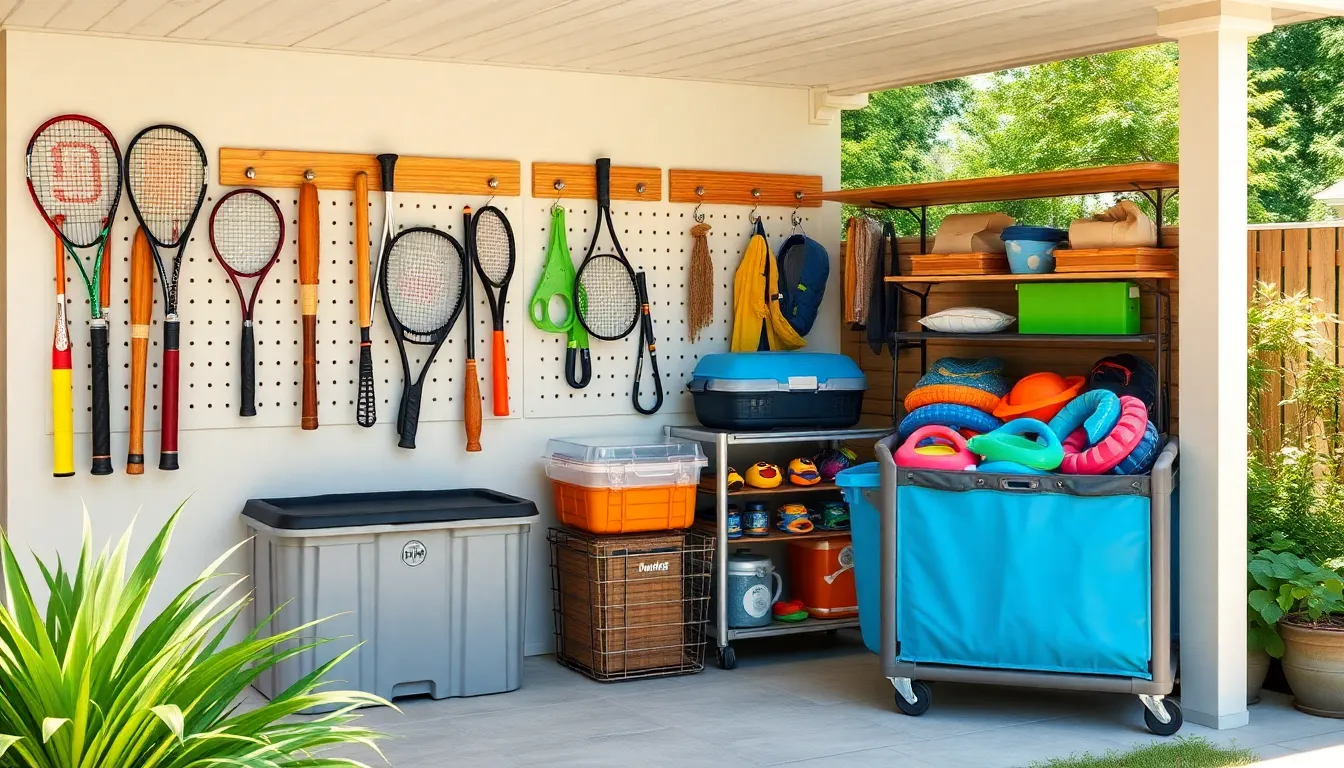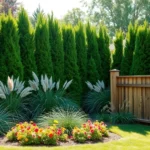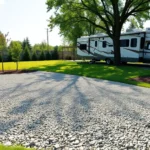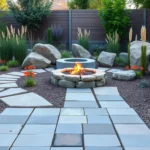We’ve all been there – staring at our cluttered patios, overflowing garages, and chaotic backyards wondering where to store all our outdoor gear. From garden tools and pool equipment to seasonal decorations and sports equipment, finding adequate storage space outside can feel like an impossible puzzle. The good news? You don’t need to expensive or hire contractors to solve this problem.
DIY outdoor storage answers offer the perfect blend of functionality, creativity, and cost-effectiveness. Whether you’re working with a small balcony or a sprawling backyard, we’ll show you how to maximize every square inch while keeping your belongings protected from the elements.
Ready to transform your outdoor chaos into organized bliss? We’ve compiled ingenious storage ideas that anyone can tackle, regardless of skill level or budget. Let’s jump into practical answers that’ll make your neighbors wonder how you became the ultimate outdoor organization guru.
Build a Weatherproof Storage Bench for Your Patio
Combining seating and storage, a weatherproof bench transforms your patio into an organized space while providing comfortable outdoor furniture. This DIY project offers excellent value by serving dual purposes without requiring advanced woodworking skills.
Choose the Right Materials for Durability
Cedar stands out as our top choice for outdoor storage benches due to its natural resistance to insects, rot, and moisture. This premium wood costs approximately $15-20 per board foot but delivers decades of reliable performance in harsh weather conditions.
Pressure-treated lumber provides an affordable alternative at $8-12 per board foot while maintaining excellent weather resistance. We recommend selecting boards with minimal knots and checking for the proper treatment grade stamp to ensure longevity.
Marine-grade plywood works exceptionally well for the bench top and sides, offering superior moisture resistance compared to standard plywood. Seal all edges with marine-grade polyurethane to prevent water infiltration and extend the bench’s lifespan.
Stainless steel or galvanized hardware prevents rust and corrosion that destroys outdoor furniture over time. Use 3-inch deck screws for structural connections and marine-grade hinges for the lid mechanism.
Add Cushioned Seating for Multi-Purpose Use
Outdoor foam cushions transform your storage bench into comfortable seating for entertaining guests or relaxing after yard work. Select cushions with quick-dry foam cores that resist mold and mildew in humid conditions.
Waterproof covers protect your cushions from rain and UV damage while maintaining their appearance throughout multiple seasons. We prefer covers with zipper closures that allow easy removal for washing.
Velcro strips attached to both the bench surface and cushion bottom prevent sliding during use. Position strips near each corner and center point for maximum stability.
| Cushion Thickness | Comfort Level | Best Use Case |
|---|---|---|
| 2 inches | Basic | Short-term seating |
| 4 inches | Good | Regular use |
| 6 inches | Excellent | Extended lounging |
Consider adding armrests using matching materials to increase comfort and create a more finished appearance. Armrests also provide convenient spots for placing drinks or small items.
Include Drainage Features to Prevent Water Damage
Drill 1/4-inch drainage holes every 6 inches along the bottom panel to allow trapped moisture to escape quickly. Position holes slightly off-center to prevent direct water entry while maintaining effective drainage.
Slope the bottom panel at a 2-degree angle toward the drainage holes to encourage water flow and prevent pooling. This subtle angle remains invisible to users while providing crucial moisture management.
Install weatherstripping around the lid perimeter to create a water-resistant seal without making the storage completely airtight. We recommend foam weatherstripping that compresses easily but maintains its seal over time.
Raise the entire bench 2-3 inches off the ground using pressure-treated lumber blocks or adjustable furniture feet. This elevation allows air circulation underneath and prevents direct ground contact that leads to moisture absorption.
Apply multiple coats of exterior wood sealer to all surfaces, paying special attention to end grain areas where water typically penetrates. Reapply sealer annually to maintain optimal protection against moisture damage.
Create Vertical Garden Tool Storage Solutions
Vertical storage transforms unused wall space into organized storage areas that keep our garden tools accessible and off the ground. We’ll maximize our outdoor areas by building upward instead of outward, creating efficient answers that work perfectly in small spaces.
Install Wall-Mounted Pegboards for Easy Access
Wall-mounted pegboards offer the ultimate flexibility for organizing our outdoor tools while keeping everything visible at a peek. We can customize these systems by painting them to match our outdoor decor and mounting them directly on shed walls, fence panels, or garage exteriors.
Setting up a pegboard system requires mounting the board securely to wall studs and adding various hooks, clips, and small shelves to accommodate different tool types. Hand tools like pruning shears, trowels, and watering accessories hang perfectly from pegboard hooks, while heavier items need specialized clips for secure storage.
We’ll find that pegboards excel at storing frequently used gardening supplies because everything remains visible and easily accessible. Rearranging tools becomes simple as our storage needs change throughout different gardening seasons, and the open design allows tools to air dry properly after use.
Build Custom Tool Racks Using Reclaimed Wood
Reclaimed wood projects create sturdy, eco-friendly storage answers that add rustic charm to our outdoor spaces while staying within budget. We can repurpose old pallets, fence boards, or barn wood to construct custom racks that fit our exact tool collection perfectly.
Building these racks involves creating slots or mounting hooks at intervals that match our tool handles, ensuring each carry out has its designated spot. Pallet wood works exceptionally well because the existing slat spacing often aligns with standard tool handle widths, requiring minimal modification.
We’ll discover that custom dimensions allow us to accommodate everything from short hand tools to medium-length implements like cultivators and edgers. These wood racks withstand outdoor conditions naturally, and we can treat them with weatherproofing stain to extend their lifespan while maintaining that authentic, weathered appearance.
Design Hanging Systems for Long-Handled Tools
Hanging systems provide secure storage for our rakes, shovels, hoes, and other long-handled implements that don’t fit well in traditional storage methods. We can create these systems using horizontal beams suspended between two vertical posts or mounted directly to existing structures.
One effective DIY approach involves setting two wooden poles vertically in the ground approximately six feet apart, then installing cross beams at shoulder height to create hanging points. We’ll space these beams carefully to prevent tools from slipping through while ensuring easy removal when needed.
| System Type | Material Cost | Installation Time | Tool Capacity |
|---|---|---|---|
| Pole-mounted beams | $25-40 | 2-3 hours | 8-12 tools |
| Wall-mounted horizontal rack | $15-25 | 1-2 hours | 6-10 tools |
| Fence-attached system | $20-30 | 1.5-2.5 hours | 10-15 tools |
Beam stability becomes crucial for preventing tools from falling, so we’ll use sturdy lumber like pressure-treated 2x4s or natural cedar posts that can support the weight of multiple heavy tools. This system keeps long handles organized vertically while protecting tool heads from ground contact and moisture damage.
Construct Hidden Storage Under Deck Stairs
We can transform the wasted space beneath deck stairs into valuable hidden storage compartments. Building these concealed areas involves framing out the space and installing doors or removable panels that blend seamlessly with your deck’s design.
Use Dead Space with Pull-Out Drawers
Pull-out drawers maximize storage potential in narrow or awkward spaces under deck stairs. We recommend installing these sliding compartments along deck risers or directly beneath stair treads for easy access to small tools, garden hoses, or grilling supplies. Drawer slides rated for outdoor use ensure smooth operation even in harsh weather conditions.
Building these drawers starts with measuring the available space and creating a frame using pressure-treated lumber. We suggest using weatherproof plywood for the drawer boxes and adding handles that match your deck’s hardware. Each drawer can hold up to 50 pounds when properly supported with heavy-duty slides.
Install Hinged Panels for Quick Access
Hinged panels provide instant access to stored items without requiring extra clearance space. We integrate these panels directly into decking boards or fence walls to create seamless storage compartments for firewood, BBQ supplies, or sports equipment. Waterproof hinges prevent rust and ensure long-lasting operation.
Securing these panels requires cutting access openings and reinforcing the surrounding structure with additional framing. We recommend using stainless steel or marine-grade hinges that can support panel weights of 25-40 pounds. Adding weatherstripping around panel edges keeps moisture out while maintaining a clean appearance.
Add Ventilation to Prevent Moisture Buildup
Ventilation systems prevent mold, mildew, and rust from damaging stored items in enclosed spaces. We install vents or create slatted panels that allow consistent airflow throughout storage compartments. This approach keeps cushions, fabrics, and metal tools dry even during humid conditions.
Strategic vent placement includes adding intake vents near the bottom and exhaust vents at the top of storage areas. We use corrosion-resistant vent covers that blend with deck materials while providing adequate airflow. Proper ventilation combined with weather-resistant sealants extends storage life by 3-5 years compared to unventilated compartments.
Design a Multipurpose Outdoor Storage Shed
Building a multipurpose outdoor storage shed transforms your backyard organization while maximizing every square foot of available space. We’ll guide you through creating a versatile structure that serves multiple functions beyond simple storage.
Plan the Perfect Size for Your Space and Needs
Measuring your available yard space comes first when planning your multipurpose shed dimensions. We recommend starting with a complete inventory of items you’ll store, including garden tools, outdoor cushions, toys, firewood, and BBQ supplies to determine the minimum square footage required.
Storage Planning Considerations:
| Item Category | Space Requirements | Access Frequency |
|---|---|---|
| Garden tools | 2-3 feet of wall space | Daily use |
| Outdoor cushions | 4-6 cubic feet | Seasonal |
| Firewood | 8-10 square feet floor space | Weekly |
| BBQ supplies | 2-3 shelves | Regular use |
Adding 20% extra space beyond your calculated needs allows for future storage expansion and easier movement inside the shed. We suggest designing door openings at least 36 inches wide to accommodate larger items like lawnmowers or patio furniture. Strategic placement of frequently used items near the entrance saves time and effort during daily tasks.
Balancing your shed’s footprint with your yard’s proportions creates visual harmony while maintaining practical functionality. We always prioritize accessibility over maximum storage capacity to ensure your shed remains user friendly throughout the seasons.
Choose Between Lean-To and Freestanding Styles
Selecting between lean-to and freestanding shed styles depends on your available space, budget, and design preferences. We’ll explore both options to help you make the best choice for your property.
Lean-to sheds attach directly to existing structures like your house, garage, or fence, making them ideal for smaller yards where space is at a premium. These designs typically cost 30-40% less than freestanding options because they share one wall with the existing structure. Installation becomes simpler since you’re working with three walls instead of four, and the shared wall often provides additional structural support.
Freestanding sheds offer complete design flexibility and can be positioned anywhere in your yard that meets local building codes. We find these structures work best when you need 360-degree access or want to create a focal point in your industry design. Construction requires a dedicated foundation and four complete walls, which increases both materials and labor costs.
Space constraints often determine the best choice for your situation. We recommend lean-to designs for narrow side yards or areas within 10 feet of existing structures, while freestanding sheds work better in open yard spaces where aesthetics and accessibility from all sides matter most.
Incorporate Windows and Shelving Systems
Adding windows to your multipurpose shed dramatically improves functionality by providing natural lighting and essential ventilation. We recommend installing at least one window on the south facing wall to maximize daylight hours and reduce the need for artificial lighting during daytime use.
Strategic window placement prevents mold buildup by encouraging air circulation while making it easier to locate stored items quickly. Installing operable windows allows you to control ventilation based on weather conditions and seasonal storage needs.
Shelving systems transform your shed’s vertical space into organized storage zones customized to your exact items. Wall mounted pegboards accommodate hand tools and lightweight supplies while providing visual organization that saves time during busy gardening seasons. Built in cupboards protect sensitive items from dust and moisture while maintaining a clean, organized appearance.
Adjustable shelving units offer the flexibility to reconfigure storage spaces as your needs change throughout the year. We suggest designing shelves with exact purposes in mind: garden pot storage requires wider, shallower shelves, while firewood storage needs deeper compartments with adequate ventilation.
Vertical storage answers maximize every inch of available space through hanging mason jars for small hardware, strategically placed hooks for tools, and pallet organizers that can be customized for your exact storage requirements. These systems keep frequently used items within easy reach while maintaining the shed’s multipurpose functionality.
Build Weather-Resistant Storage Boxes and Containers
Creating durable outdoor storage containers protects your belongings from harsh weather conditions while maintaining long-term functionality. Weather-resistant storage boxes require careful material selection and design features that prevent moisture damage and extend their lifespan.
Select Appropriate Wood Treatment Options
Pressure-treated lumber provides excellent resistance to decay and insects, making it our preferred choice for outdoor storage projects. Cedar and composite decking boards offer natural weather resistance while maintaining attractive appearances throughout changing seasons. Marine-grade plywood withstands moisture fluctuations better than standard plywood, preventing warping and delamination over time.
Applying weatherproof sealants creates an additional protective barrier against rain and snow penetration. Outdoor-grade paints not only enhance visual appeal but also shield wood surfaces from UV damage and temperature extremes. Regular maintenance including reapplying protective coatings every 2-3 years ensures maximum durability and preserves the wood’s structural integrity.
Waterproof stains penetrate deep into wood fibers while allowing natural grain patterns to remain visible. Multiple thin coats provide better protection than single thick applications, reducing the risk of peeling and flaking. Annual inspections help identify areas requiring touch-up treatments before important damage occurs.
Create Stackable Modular Storage Units
Modular storage systems maximize space efficiency while providing flexible organization options for various outdoor items. Stackable crates and compartments allow us to customize storage configurations based on seasonal needs and available space. Separate units can be moved individually during severe weather conditions, protecting contents from potential damage.
Designing uniform dimensions across multiple units ensures stable stacking and professional appearance. Standard crate sizes like 18″ x 12″ x 10″ work well for most garden tools and outdoor accessories. Interlocking features such as rabbeted edges or corner brackets prevent shifting during windy conditions.
Vertical storage answers using wall-mounted hooks and hanging buckets use fence space effectively while keeping items accessible. Modular bench systems combine seating functionality with hidden storage compartments underneath. Removable dividers within larger containers create organized sections for different item categories.
Install Secure Locking Mechanisms
Security features protect valuable outdoor equipment from theft while deterring curious animals from accessing stored items. Weatherproof padlocks resist rust and corrosion better than standard locks, maintaining smooth operation throughout multiple seasons. Heavy-duty hasps and reinforced mounting points provide tamper-resistant security for storage boxes and cabinets.
Integrated locking systems built into hinged lids offer cleaner appearances than external hardware while providing equivalent security levels. Marine-grade stainless steel components prevent corrosion in coastal environments and high-humidity conditions. Combination locks eliminate key management concerns while providing reliable access control.
Hidden latch mechanisms disguised within decorative elements maintain aesthetic appeal while securing contents effectively. Cylinder locks with weather shields protect internal mechanisms from moisture infiltration and debris accumulation. Dual locking points on larger containers distribute stress loads and enhance overall security performance.
Repurpose Everyday Items for Creative Storage
We can unlock incredible storage potential by transforming common household items into functional outdoor organizers. Creative repurposing saves money while adding unique character to our outdoor spaces.
Transform Old Dressers into Garden Supply Stations
Old dressers become excellent garden supply stations with minimal weatherproofing efforts. We recommend applying outdoor-friendly paint to protect the wood from moisture and UV damage. Adding functional hardware like wheels transforms a stationary dresser into a mobile garden cart that moves easily around our yard.
Multiple drawers provide organized compartments for seeds, hand tools, fertilizers, and small gardening supplies. The dresser’s top surface creates a perfect potting bench for transplanting seedlings or preparing garden beds. Vintage charm combines with practical functionality when we give forgotten furniture a new outdoor purpose.
Weather-resistant finishes ensure our repurposed dresser withstands seasonal changes while maintaining its attractive appearance. Storage capacity multiplies compared to traditional outdoor containers, making this DIY solution both space-efficient and budget-friendly.
Convert Plastic Barrels into Tool Organizers
Plastic barrels offer weather-resistant storage that handles outdoor conditions exceptionally well. Repurposed wine barrels can be cut in half to create rustic storage bins perfect for firewood or large garden tools. We can adapt these sturdy containers by creating internal compartments or slots for different tool types.
Cutting techniques allow us to customize barrel heights based on our exact storage needs. Drainage holes prevent water accumulation during rainy seasons, protecting metal tools from rust damage. The curved shape of barrels maximizes storage volume while their plastic construction resists cracking in freezing temperatures.
Decorative potential makes plastic barrels blend seamlessly with backyard aesthetics when we add paint or natural finishes. Multiple barrels can stack or nest together for compact storage when not in use.
Upcycle Pallets for Versatile Storage Answers
Wooden pallets provide the foundation for countless DIY outdoor storage projects due to their sturdy construction and widespread availability. We can convert pallets into rustic tool racks by adding hooks and brackets for hanging garden tools and hoses. Their open slat design promotes air circulation, preventing moisture buildup that damages stored items.
Vertical planters with hidden compartments offer dual functionality by growing plants while storing gardening supplies discreetly. Pallet wood can be disassembled and rebuilt into custom storage boxes sized perfectly for our available space. The natural wood appearance adds organic charm to outdoor areas without requiring expensive materials.
Budget-friendly answers emerge when we source free pallets from local businesses or shipping companies. Standard pallet dimensions provide consistent building materials for multiple storage projects throughout our property. Weather treatment with outdoor stains or sealers extends pallet life while maintaining their rustic appeal.
Install Overhead Storage Systems for Maximum Space
Overhead storage systems transform unused ceiling space into valuable storage real estate that keeps our outdoor areas organized and clutter-free. We can dramatically increase our storage capacity without sacrificing precious floor space by utilizing the vertical dimensions of covered outdoor areas.
Mount Ceiling Racks in Covered Areas
Ceiling racks provide the perfect solution for storing bulky seasonal items like holiday decorations, sports equipment, and garden tools in covered spaces such as garages, patios, or areas under decks. We recommend installing heavy-duty ceiling mounted racks using weather-resistant materials that can withstand occasional exposure to moisture and temperature fluctuations.
Weather-resistant steel or aluminum racks offer exceptional durability and can safely hold boxes, bins, and less frequently used items overhead. These systems work particularly well in covered outdoor areas where we need protection from direct weather exposure while maintaining easy access to stored belongings.
Installing ceiling racks requires securing them to ceiling joists or structural beams to ensure they can support the intended weight load. We suggest using galvanized bolts and brackets that won’t rust over time, especially in humid outdoor environments.
Create Pulley Systems for Seasonal Items
Pulley systems eliminate the need for ladders when accessing overhead storage, making seasonal item retrieval safer and more convenient. We can create DIY pulley mechanisms using marine-grade rope, pulleys rated for outdoor use, and secure mounting hardware that allows us to raise and lower storage containers with minimal effort.
Building a pulley system involves mounting pulleys to ceiling beams and creating a rope system that connects to storage platforms or bins. This approach works exceptionally well for items we only need periodically, such as holiday decorations, winter equipment, or summer cushions that require protected storage during off seasons.
Rope and pulley combinations provide mechanical advantage, making it easier to lift heavier loads overhead while keeping them securely stored when not in use. We recommend using weatherproof pulleys and synthetic rope that resists moisture and UV damage for long-lasting performance.
Design Drop-Down Storage for Easy Retrieval
Drop-down storage units combine the space-saving benefits of overhead storage with the accessibility of ground-level systems through platforms that lower on demand. We can design these systems using hinged platforms, adjustable chains, or cable mechanisms that allow storage areas to be lowered for loading and unloading, then raised back to ceiling level.
These systems require sufficient ceiling height to accommodate the lowering mechanism while maintaining headroom for safe operation. Drop-down storage works particularly well in covered areas like garages or large patio spaces where we have adequate vertical clearance.
Constructing drop-down storage involves creating sturdy platforms with reliable lowering mechanisms that can safely support the intended load while providing smooth operation. We suggest incorporating safety features like locking mechanisms to prevent accidental lowering and ensure stored items remain secure when elevated.
Organize Pool and Outdoor Recreation Equipment
Pool equipment and outdoor recreation gear can quickly take over your outdoor space without proper organization. We’ll explore three essential DIY storage answers to keep everything tidy and accessible.
Build Dedicated Sports Equipment Racks
Wall-mounted pegboards offer the most versatile solution for organizing sports equipment like baseball bats, tennis rackets, and balls. Installing these boards on garage walls or shed interiors creates instant access to frequently used items while keeping them off the ground and properly displayed.
Wooden pallets provide excellent raw material for custom sports equipment racks that cost significantly less than store-bought alternatives. Repurposing these pallets into vertical storage units allows you to accommodate everything from basketballs to hockey sticks in one organized space.
Free-standing metal shelving works perfectly for larger sports items that don’t hang well on pegboards. Stacking adjustable shelves creates compartments for bulky equipment like coolers, camping gear, and exercise equipment while maintaining easy access to each item.
Adjustable wall hangers solve the challenge of storing oddly shaped equipment that traditional shelving can’t handle effectively. These specialized hooks accommodate items like fishing rods, pool noodles, and athletic nets without causing damage or creating clutter.
Create Waterproof Storage for Pool Supplies
Weather-resistant deck boxes specifically designed for outdoor use protect pool chemicals, cleaning supplies, and maintenance tools from moisture damage year-round. These waterproof containers prevent mold and mildew while keeping hazardous chemicals safely contained and away from children.
Upcycled cabinets treated with outdoor-friendly paint transform into budget-conscious waterproof storage units perfect for pool supplies. Applying marine-grade sealants to these repurposed pieces ensures they withstand constant exposure to pool chemicals and humidity without deteriorating.
Plastic storage bins with tight-fitting lids offer the most cost-effective waterproof solution for organizing smaller pool accessories and toys. Labeling these containers by category helps family members quickly locate exact items while maintaining the organized system throughout the swimming season.
Sealed wooden storage benches combine seating functionality with waterproof storage capacity for pool cushions and towels. Treating these benches with waterproof coatings creates dual-purpose furniture that enhances your pool area’s aesthetics while providing essential storage space.
Design Mobile Storage Carts for Easy Transport
Utility carts with sturdy wheels eliminate the hassle of carrying pool supplies and sports equipment between storage areas and usage locations. Building these mobile units with multiple shelves allows you to segregate equipment by function while ensuring everything moves together efficiently.
Repurposed rolling carts from old furniture pieces create custom storage answers that match your outdoor décor perfectly. Adding weather-resistant casters designed for outdoor terrain ensures these DIY carts remain functional across different surfaces like concrete, grass, and gravel.
Lightweight materials combined with durable construction make these mobile storage units easy to maneuver without sacrificing capacity or longevity. Using materials like marine-grade plywood and aluminum framing creates carts that withstand outdoor conditions while remaining light enough for easy transport.
Compartmentalized designs within mobile carts improve organization by creating designated spaces for different types of equipment. Installing removable dividers allows you to customize the internal layout based on seasonal needs and changing equipment collections.
Conclusion
We’ve explored many DIY outdoor storage answers that can transform your backyard into an organized and functional space. From weatherproof benches to vertical tool racks and overhead systems these projects prove that effective storage doesn’t require professional installation or expensive materials.
The key to successful outdoor storage lies in selecting weather-resistant materials and incorporating proper ventilation to protect your belongings. Whether you’re working with a small patio or spacious backyard these adaptable answers can be customized to fit your exact needs and budget.
Start with one simple project like a repurposed storage container or basic tool rack then gradually expand your outdoor organization system. With these DIY approaches you’ll maximize your outdoor space while keeping everything easily accessible and protected from the elements.
Frequently Asked Questions
What materials work best for DIY outdoor storage projects?
Cedar, pressure-treated lumber, and marine-grade plywood are the most durable options for outdoor storage. These materials naturally resist moisture, insects, and weather damage. For added protection, apply weatherproof sealants and use stainless steel hardware to prevent rust and ensure long-lasting storage solutions.
How can I maximize storage in a small outdoor space?
Focus on vertical storage solutions like wall-mounted pegboards, overhead ceiling racks, and stackable modular containers. Utilize wasted spaces under deck stairs and create multipurpose furniture like storage benches. These strategies help you store more items without taking up valuable floor space.
What’s the most budget-friendly way to create outdoor storage?
Repurpose everyday items like old dressers, plastic barrels, and wooden pallets. These materials are often free or inexpensive and can be transformed into functional storage solutions with minimal investment. Upcycling saves money while adding unique character to your outdoor space.
How do I protect outdoor storage from weather damage?
Install proper drainage systems with holes and sloped bottoms to prevent water accumulation. Use weatherstripping around doors and lids, elevate storage containers off the ground, and ensure adequate ventilation to prevent moisture buildup. Apply regular maintenance with weatherproof sealants for continued protection.
Can I build outdoor storage without professional carpentry skills?
Absolutely! Many DIY outdoor storage projects require only basic tools and beginner-level skills. Start with simple projects like storage benches or tool racks using clear instructions and pre-cut materials. Most projects can be completed in a weekend with common household tools.
What size storage shed should I build for my backyard?
First, inventory all items you plan to store, then add 20-30% extra space for future needs. Consider your available yard space and local building codes. A 6×8 foot shed typically accommodates basic garden tools and equipment, while larger families may need 8×10 or 10×12 foot structures.
How can I organize tools in my outdoor storage area?
Use pegboards for hand tools, build custom racks for long-handled equipment, and install adjustable shelving systems. Group similar items together and keep frequently used tools at eye level. Label storage areas and use clear containers to easily identify contents at a glance.
What’s the best way to store pool equipment outdoors?
Build waterproof storage benches or use weather-resistant deck boxes specifically designed for pool chemicals and accessories. Create mobile storage carts for easy transport and install wall-mounted racks for equipment like skimmers and brushes. Always ensure proper ventilation for chemical storage.
How do I prevent theft of outdoor storage items?
Install secure locking mechanisms on all storage containers, including heavy-duty padlocks and reinforced hinges. Consider motion-sensor lighting around storage areas and anchor larger storage units to concrete foundations. For valuable items, use storage containers that aren’t obviously storage units.
Can overhead storage work in uncovered outdoor areas?
Overhead storage works best in covered spaces like garages, carports, or covered patios. For uncovered areas, focus on weatherproof ground-level storage solutions instead. If you must use overhead storage outdoors, ensure items are completely waterproof and the mounting system is designed for outdoor conditions.

